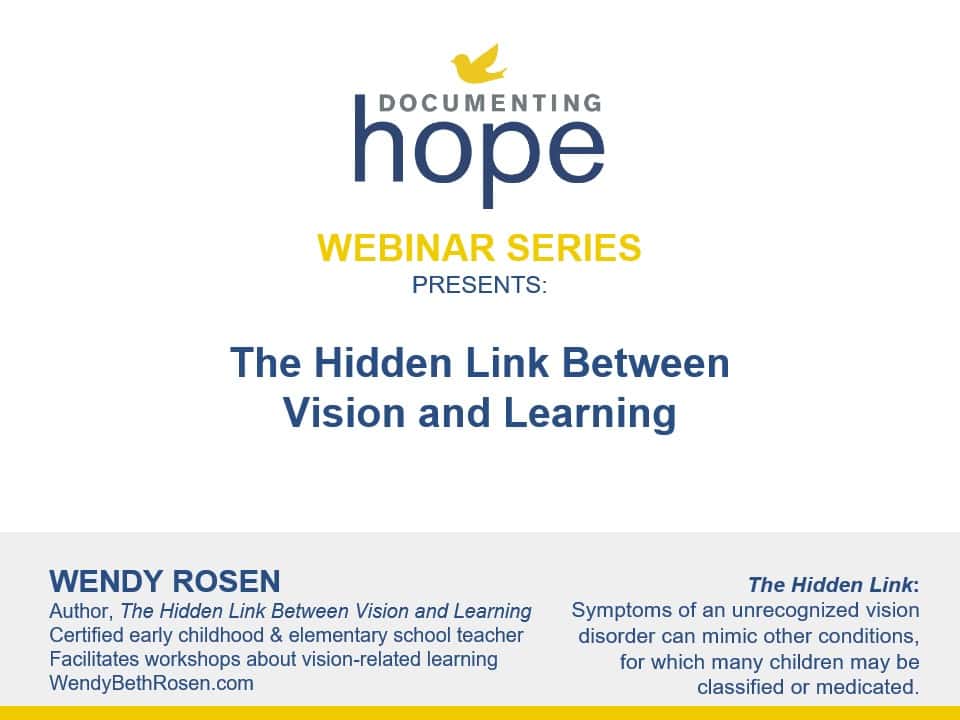We interviewed Bryce Appelbaum OD FCOVD about how developmental optometry can help reverse symptoms of autism, ADHD, SPD and learning disabilities. You can watch the replay below. Please note that you will be asked to provide your email address at the 30-minute mark to continue viewing the replay.
What Is Developmental Optometry?
Developmental optometry, also known as behavioral optometry, is a specialized field of optometry that focuses on enhancing visual performance and treating various vision conditions beyond just visual acuity, which addresses the issue of “do you have 20/20 vision?”. Developmental optometrists diagnose vision issues such as eye-tracking difficulties, double vision, convergence disorders, visual-perception problems, strabismus and amblyopia.
These specialized optometrists use techniques and tools such as prisms, lenses and vision therapy. Vision therapy involves a sequence of eye exercises designed to improve visual efficiency and help the eyes and brain work more effectively together. This approach is particularly beneficial for children who have functional vision problems that impair their ability to read, learn, or maintain attention.
Who Can Developmental Optometry Help?
Developmental optometry can help children with neurodevelopmental and neurological symptoms, such as those with:
- Dyslexia
- Trauamatic Brain Injury
- Developmental delays
- Vision-proccesing challenges
- Eye strain
- Vertigo
- Motor coordination difficulties
In This Webinar
In this webinar, Dr. Appelbaum helped us to answer the following questions:
- What is developmental optometry?
- How is develomental optometry different than visual-acuity screenings?
- What is vision therapy?
- How can vision therapy help children with neurodevelopmental and neurological disorders?
- What are examples of how some of these children have been helped with vision therapy?
- Do children who do vision therapy experience reduction in other symptoms?
Key Discussions
Vision Therapy’s Role in Developmental Issues
Vision therapy can play a significant role in addressing symptoms related to autism, ADHD, Sensory Processing Disorder, and learning disabilities by improving how the eyes and brain work together. It offers a proactive approach to developmental delays, enhancing everyday functioning and learning capabilities.
The Difference Between Eyesight and Vision
It’s important to distinguish between eyesight and vision. Eyesight refers to the ability to see fine details, often addressed with glasses. Vision involves processing visual information by the brain, affecting reading, learning, and spatial awareness. Developmental optometry focuses on improving vision rather than just eyesight.
The Impact of Technology and Environment on Vision
Increased screen time and early exposure to technology have exacerbated visual developmental delays. Reducing screen time and increasing outdoor activities are essential for proper vision development. Digital performance lenses can help mitigate some screen-related visual stress.
Holistic Health and Functional Vision
Vision health is intertwined with overall health, including diet, lifestyle, and neurological impact. The approach should consider nutritional support, reducing inflammation, and addressing root causes, as vision is linked to brain function and overall sensory integration.
Neuroplasticity and Rehabilitation Potential
The brain’s ability to adapt and change (neuroplasticity) allows for vision improvements at any age. Vision therapy not only helps children with developmental delays but can also benefit adults, athletes, and those who have experienced brain injuries, highlighting the potential for lifelong vision rehabilitation.
Resources Mentioned in This Webinar
CBS Chicago: Vision Problems In Kids Can Be Misdiagnosed For ADHD
Surviving Mold: Visual Contrast Senstitivity test
Success Story: Whitman’s Reversal of Lyme Symptoms
Vision Therapy Transformed Our Son’s Life: Atlas’ Story
Catching a Ball for the First Time at 39: Justin’s Story
Documenting Your Own Hope with a Case Report
D’Adamo, C.R., et al. Reversal of Autism Symptoms among Dizygotic Twins through a Personalized Lifestyle and Environmental Modification Approach: A Case Report and Review of the Literature. J Pers Med. 2024, 14(6), 641.
The Biology of Trauma® with Aimie Apigian MD MS MPH
Optometric Vision Development Rehabilitation Association
Neuro-Optometric Rehabilitation Association
Doidge, Norman. The Brain That Changes Itself: Stories of Personal Triumph from the Frontiers of Brain Science.
Neuroplasticity: How to Heal a Broken Brain
Robbins, Jim. A Symphony in the Brain: The Evolution of the New Brain Wave Biofeedback.
About Bryce Appelbaum OD FCOVD
Dr. Appelbaum is on a mission to change the way the world views vision. He believes there is more to vision than just 20/20 eyesight and has developed programs to retrain the brain to revise the eyes. He is a pioneer in neuro-optometry passionate about unlocking life’s potential through vision. His expertise includes reorganizing the visual brain post-concussion to return to learn and return to life, remediating visual developmental delays interfering with reading and learning, and enhancing visual skills to elevate sports performance.
He is the founder and CEO of MyVisionFirst, with a private practice specializing in Vision Therapy and Rehabilitation and offices in Bethesda and Annapolis, Maryland. He is also the founder and CEO of ScreenFit, the revolutionary online vision training program designed to minimize the damage of digital devices on vision, reduce symptoms, and promote healthy visual habits for extended screen use.

Dr. Appelbaum has worked with hundreds of professional athletes, numerous professional and collegiate sports teams, and countless amateur athletes to transform raw talent into honed performance through vision. These athletes include:
- NFL, NBA, MLB, NHL, MLS, and NWSL players
- Professional golfers, volleyball and tennis players, race car drivers
- Olympic fencers, gymnasts, swimmers, skiers, archers, and shooters
Dr. Appelbaum is a board-certified Fellow of the College of Optometrists in Vision Development and an Adjunct Clinical Professor at the Southern College of Optometry. He completed his undergraduate degree from Washington University in St. Louis where he majored in psychology and pre-medical studies and graduated with clinical honors from The Illinois College of Optometry. He is certified in Corneal Refractive Therapy/Orthokeratology, a specialty contact lens approach to slowing down nearsightedness and improving eyesight as an alternative to refractive surgery. Dr. Appelbaum is a frequent podcast and media guest.
You can find out more about him and his practice at https://myvisionfirst.com/
Disclaimer
This webinar is not a substitute for medical advice, treatment, diagnosis, or consultation with a medical professional. It is intended for general informational purposes only and should not be relied on to make determinations related to treatment of a medical condition. Documenting Hope has not verified and does not guaranty the accuracy of the information provided in this webinar.
Still Looking for Answers?
Visit the Documenting Hope Practitioner Directory to find a practitioner near you.
Join us inside our online membership community for parents, Healing Together, where you’ll find even more healing resources, expert guidance, and a community to support you every step of your child’s healing journey.
Sources & References
Bakroon, A., et al. Visual function in autism spectrum disorders: a critical review. Clin Exp Optom. 2016 Jul;99(4):297-308.
Bellato, A., et al. Association between ADHD and vision problems. A systematic review and meta-analysis. Mol Psychiatry. 2023 Jan;28(1):410-422.
Bertone, A., et al. Enhanced and diminished visuo-spatial information processing in autism depends on stimulus complexity. Brain. 2005 Oct;128(Pt 10):2430-41.
Chang, M.Y., et al. Prevalence of Ophthalmologic Diagnoses in Children With Autism Spectrum Disorder Using the Optum Dataset: APopulation-Based Study. Am J Ophthalmol. 2021 Jan:221:147-153.
Davis, R.A.O., et al. Subjective perceptual distortions and visual dysfunction in children with autism. J Autism Dev Disord. 2006 Feb;36(2):199-210.
DeCarlo, D.K., et al. Prevalence of attention-deficit/hyperactivity disorder among children with vision impairment. J AAPOS. 2014 Feb;18(1):10-4.
De Jonge, M.V., et al. Visual information processing in high-functioning individuals with autism spectrum disorders and their parents. Neuropsychology. 2007 Jan;21(1):65-73.
Egset, K., et al. Magno App: Exploring Visual Processing in Adults with High and Low Reading Competence. Scandinavian Journal of Educational Research. 07 Jan 2020.
Franklin, A., et al. Reduced chromatic discrimination in children with autism spectrum disorders. Dev Sci. 2010 Jan 1;13(1):188-200.
Grigg. T.M., et al. Primitive Reflex Integration and Reading Achievement in the Classroom. Journal of Neurology and Experimental Neuroscience. 2023; 9(1), 18-26.
Ho, J.D., et al. Associations between attention-deficit/hyperactivity disorder and ocular abnormalities in children: a population-based study. Ophthalmic Epidemiol. 2020 Jun;27(3):194-199.
Kaplan, M., et al. Strabismus in Autism Spectrum Disorder. Focus on Autism and Other Developmental Disabilities. 1999.
Koh, H.C., et al. Spatial contrast sensitivity in adolescents with autism spectrum disorders. J Autism Dev Disord. 2010 Aug;40(8):978-87.
Johnson, B.P., et al. Ocular motor disturbances in autism spectrum disorders: systematic review and comprehensive meta-analysis. Neurosci Biobehav Rev. 2016 Oct:69:260-79.
Khanna, R.K., et al. Ophthalmological findings in children with autism spectrum disorder. Graefes Arch Clin Exp Ophthalmol. 2020 Apr;258(4):909-916.
Little, J.A. Vision in children with autism spectrum disorder: a critical review. Clin Exp Optom. 2018 Jul;101(4):504-513.
Maron, D.N., et al. Oculomotor deficits in attention deficit hyperactivity disorder (ADHD): a systematic review and comprehensive meta-analysis. J Autism Dev Disord. 2006 Feb;36(2):199-210.
Milne, E., et al. Vision in children and adolescents with autistic spectrum disorder: evidence for reduced convergence. J Autism Dev Disord. 2009 Jul;39(7):965-75.
Mouridsen, S.E., et al. Eye Disorders among Adult People Diagnosed with Infantile Autism in Childhood: A Longitudinal Case Control Study. Ophthalmic Epidemiol. 2017 Oct;24(5):332-335.
Padula, W.V., et al. Modifying postural adaptation following a CVA through prismatic shift of visuo-spatial egocenter. Brain Inj. 2009 Jun;23(6):566-76.
Padula, W.V., et al. Risk of fall (RoF) intervention by affecting visual egocenter through gait analysis and yoked prisms. NeuroRehabilitation. 2015;37(2):305-14.
Padula, W.V., et al. The consequence of spatial visual processing dysfunction caused by traumatic brain injury (TBI). Brain Inj.. 2017;31(5):589-600.
Padula, W.V., et al. Visual evoked potentials (VEP) evaluating treatment for post-trauma vision syndrome (PTVS) in patients with traumatic brain injuries (TBI). Brain Inj. 1994 Feb-Mar;8(2):125-33.
Perna, J., et al. Association between Autism Spectrum Disorder (ASD) and vision problems. A systematic review and meta-analysis. Mol Psychiatry. 2023 Dec;28(12):5011-5023.
Reimelt, C., et al. The underestimated role of refractive error (hyperopia, myopia, and astigmatism) and strabismus in children with ADHD. J Atten Disord. 2021 Jan;25(2):235-244.
Robertson, C.E., et al. Tunnel vision: sharper gradient of spatial attention in autism. J Neurosci. 2013 Apr 17;33(16):6776-81.
Sarno, S., et al. Electrophysiological correlates of visual impairments after traumatic brain injury. Vision Res. 2000;40(21):3029-38.
Simmons, D.R., et al. Vision in autism spectrum disorders. Vision Res. 2009 Nov;49(22):2705-39.
Stephens-Sarlós, E., et al. The efficacy of the sensorimotor training program on sensorimotor development, auditory and visual skills of schoolchildren aged 5–8 years. Child & Youth Care Forum. 2024 Aug;54(2):323-352.
Song, Y., et al. Can they see it? The functional field of view is narrower in individuals with autism spectrum disorder. PLoS One. 2015 Jul 23;10(7):e0133237.
Su, C.C., et al. Incidence and risk of attention-deficit hyperactivity disorder in children with amblyopia: a nationwide cohort study. Clin Exp Ophthalmol. 2019 Mar;47(2):259-264.
Van der Hallen, R., et al. Global Motion Perception in Autism Spectrum Disorder: A Meta-Analysis. J Autism Dev Disord. 2019 Dec;49(12):4901-4918.
Wang, J., et al. Refractive Status and Amblyopia Risk Factors in Chinese Children with Autism Spectrum Disorder. J Autism Dev Disord. 2018 May;48(5):1530-1536.
Whatham, A., et al. Vitamin and mineral deficiencies in the developed world and their effect on the eye and vision. Ophthalmic Physiol Opt. 2008 Jan;28(1):1-12.
Resources
Articles
CBS Chicago: Vision Problems In Kids Can Be Misdiagnosed For ADHD
Move, Play, Thrive: Vision Doctor on Rhythmic Movements + Research about Visual Processing Issues.
Books
Hellerstein, Lynn. 50 Tips to Improve Your Sports Performance. HiClear Publishing LLC, 2013.
Hellerstein, Lynn. Expand Your Vision Beyond Sight.HiClear Publishing LLC, 2012.
Hellerstein, Lynn. Organize It. HiClear Publishing LLC, 2010.
Hellerstein, Lynn. See It, Say It, Do It. HiClear Publishing LLC, 2012.
Lemer, Patricia S. Envisioning a Bright Future: Interventions That Work for Children and Adults with Autism Spectrum Disorders. Optometric Extension Program Foundation, 2008.
Videos
Catching a Ball for the First Time at 39: Justin’s Story
Vision Therapy Transformed Our Son’s Life: Atlas’ Story
Websites
Neuro-Optometric Rehabilitation Association
Optometric Vision Development Rehabilitation Association




